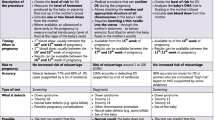Abstract
Objective: To assess trends in prenatal discussions about HIV testing and prenatal HIV testing during the period 1996–2001. Methods: Using data from the Pregnancy Risk Assessment Monitoring System, a population-based postpartum survey of women, we calculated the self-reported prevalences of discussion of prenatal HIV testing and testing. Data were analyzed using SUDAAN; trends were calculated by logistic regression for states having ≥3 years of data. Results: From 1996 to 2001, significant increases in prenatal discussions about HIV testing were seen in 15 of 17 states. During the period 1996–2001, the prevalence of testing increased significantly in 7 of 8 states. In all states, there was a significant, positive relationship between having a prenatal discussion about testing and having an HIV test (odds ratios ranged from 1.7 to 4.9). Conclusions: We found statistically significant increases in discussions and testing from 1996 through 2001, consistent with guidelines emphasizing routine prenatal testing. Health care providers may have a strong influence on women’s decisions to be tested. Because current guidelines call for simplified strategies to reduce barriers to universal prenatal HIV screening, trends in prenatal HIV testing should continue to be monitored to assess the impact of these changes.
Similar content being viewed by others
References
Centers for Disease Control and Prevention. Recommendations of the US Public Health Services Task Force on the use of zidovudine to reduce perinatal transmission of human immunodeficiency virus. MMWR Morb Mortal Wkly Rep 1994;43(RR-11):1–20.
Centers for Disease Control and Prevention. US Public Health Service recommendations for human immunodeficiency virus counseling and voluntary testing for pregnant women. MMWR Morb Mortal Wkly Rep 1995;44(RR-7):1–15.
Lansky A, Jones JL, Frey RL, et al. Trends in HIV testing among pregnant women-United States, 1994–1999. Am J Public Health 2001;91:1291–3.
Centers for Disease Control and Prevention. Prenatal discussion of HIV testing and maternal HIV testing—14 states, 1996–1997. MMWR Morb Mortal Wkly Rep 1999;48:401–4.
Centers for Disease Control and Prevention. Revised recommendations for HIV screening of pregnant women. MMWR Morb Mortal Wkly Rep 2001;50(RR-19):59–86.
Centers for Disease Control and Prevention. Advancing HIV prevention: New strategies for a changing epidemic—United States, 2003. MMWR Morb Mortal Wkly Rep 2003;52:329–32.
Centers for Disease Control and Prevention. Revised recommendations for HIV testing of adults, adolescents, and pregnant women in health-care settings. MMWR Recommendations and Rep 2006;55(RR-14):1–17.
Centers for Disease Control and Prevention. HIV testing among pregnant women—United States and Canada, 1998–2001. MMWR Morb Mortal Wkly Rep 2002;51:1013–6.
Anderson JE, Santelli J, Mugalla C. Changes in HIV-related HIV preventive behavior in the US population: Data from national surveys, 1987–2002. J Acquir Imm Defic Syndr 2003;34:195–202.
Williams L, Morrow B, Lansky A, et al. Surveillance for selected maternal behaviors and experiences before, during, and after pregnancy, Pregnancy Risk Assessment Monitoring System (PRAMS), 2000. MMWR Surveill Summ 2003;52(SS-11):1–20.
Centers for Disease Control and Prevention (CDC). PRAMS model surveillance protocol. Atlanta Ga: 2003. Available from the Division of Reproductive Health, CDC, 4770 Buford Hwy, MS K-22, Atlanta, GA 30341.
Shulman HB, Colley Gilbert B, Lansky A. The Pregnancy Risk Assessment Monitoring System (PRAMS): Current methods and evaluation of 2001 response rates. Public Health Rep 2006;121:74–83.
CDC. Technical guidance on HIV counseling. MMWR Morb Mortal Wkly Rep 1993;42(RR-2):8–17.
American Academy of Pediatrics Committee on Fetus and Newborn, American College of Obstetricians and Gynecologists Committee on Obstetric Practice. Guidelines for perinatal care. 5th ed. Elk Grove Village, IL: American Academy of Pediatrics; Washington, DC: American College of Obstetricians and Gynecologists, 2002.
SUDAAN. Release 9.0. Research Triangle Park, NC: Research Triangle Institute; 2005.
Wong VK, Silebi M. HIV testing of pregnant women: risk factors [I44]. Presented at: Interscience Conference on Antimicrobial Agents and Chemotherapy; 1996; Chicago.
Carusi D, Learman LA, Posner SF. Human immunodeficiency virus test refusal in pregnancy: A challenge to voluntary testing. Obstet Gynecol 1998;91:540–5.
Rivero Y, Fernandez MI, O’Sullivan MJ, et al. Effect of name reporting on HIV testing rates among women in prenatal care in Miami [43129]. Presented at: XII International Conference on AIDS; 1998; Geneva.
Royce RA, Water EB, Fernandez MI, et al., for the Perinatal Guidelines Evaluation Project. Barriers to universal prenatal HIV testing in 4 US locations in 1997. Am J Public Health 2001;91:727–33.
Tyroch AH, Kaups KL, Rohan J, et al. Pregnant women and car restraints: beliefs and practices. J Trauma-Injury Infect Crit Care 1999;46(2):241–5.
Beck LF, Morrow B. Impact of questionnaire changes on observed prevalence of prenatal counseling. Am J Epidemiol 2003;157(11):S53. Abstract 210.
Schrag S, Arnold K, Mohle-Boetani J, et al. Prenatal screening for infectious diseases and opportunities for prevention. Obstet Gynecol 2003;102:753–60.
Acknowledgments
The authors would like to acknowledge the contributions of the PRAMS project staff and participants, and the PRAMS Working Group: Alabama—Rhonda Stephens, MPH; Alaska—Kathy Perham-Hester, MS, MPH; Arkansas—Gina Redford, MAP; Colorado—Alyson Shupe, PhD; Florida—Helen Marshall; Georgia—Carol Hoban, MS, MPH; Hawaii—Limin Song, MPH, CHES; Illinois—Theresa Sandidge, MA; Louisiana—Joan Wightkin; Maine—Martha Henson; Maryland—Diana Cheng, MD; Michigan—Yasmina Bouraoui, MPH; Minnesota—Jan Jernell; Mississippi—Linda Pendleton, LMSW; Montana—JoAnn Dotson; Nebraska—Jennifer Severe-Oforah; New Jersey—Lakota Kruse, MD; New Mexico—Ssu Weng, MD, MPH; New York State—Anne Radigan-Garcia; New York City—Candace Mulready, MPH; North Carolina—Paul Buescher, PhD; North Dakota—Sandra Anseth, RN; Ohio—Amy Davis; Oklahoma –Dick Lorenz; Oregon—Ken Rosenberg, MD, MPH; Rhode Island—Sam Viner-Brown; South Carolina—Sylvia Sievers, PhD; Texas—Tanya J. Guthrie, PhD; Utah—Lois Bloebaum; Vermont—Peggy Brozicevic; Washington—Linda Lohdefinck; West Virginia—Melissa Baker, MA; CDC PRAMS Team, Applied Sciences Branch, Division of Reproductive Health.
Author information
Authors and Affiliations
Corresponding author
Rights and permissions
About this article
Cite this article
Lansky, A., Sansom, S.L., Harrison, L.L. et al. Trends in Prenatal Discussion and HIV Testing, 1996–2001: Pregnancy Risk Assessment Monitoring System. Matern Child Health J 11, 526–531 (2007). https://doi.org/10.1007/s10995-007-0197-0
Received:
Accepted:
Published:
Issue Date:
DOI: https://doi.org/10.1007/s10995-007-0197-0



